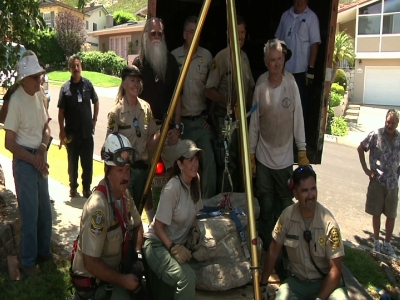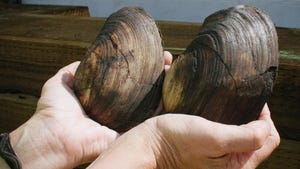
Beachgoers often take home a souvenir from the sands of Long Beach Island, such as a pretty seashell or if they're lucky, a rare piece of sea glass.
But 10-year-old Noah Cordle, a visitor from Virginia,found something truly extraordinary: a 10,000-year-old Paleoindian arrow point. Ancient Native Americans used such arrows to spear fish and to hunt mastodon.
Last week, the arrow clunked against Noah's leg as he stood at the edge of the surf in Beach Haven. It was still sharp enough to hurt.
"I thought it was a crab," Noah said.
When he picked up the pointy, black, 2.5-inch object, he figured he better show it to his parents, Andrea and Brian Cordle. His 6-year-old sister, Natalie, was unimpressed. But his parents were excited.
His mother contacted Greg Lattanzi, president of the Archaeological Society of New Jersey and assistant curator of the archeology and ethnography bureau of the New Jersey State Museum in Trenton.
"I was basically blown away," Lattanzi said. "Finding these points is rare."
How rare? The State Museum maintains a collection of about 20 to 25 Paleoindian points, but most were unearthed by professionals at archaeological digs.
"Only one other one recorded had washed up on a beach," he said, "on Island Beach State Park in '94 or '95."
Lattanzi examined Noah's discovery under a microscope and determined it to be a stone projectile point, made of jasper. He estimated its age as between 8,000 and 11,000 years old, based on the arrow's style and construction.
"Jasper is a yellow-brown stone," Lattanzi said. "The reason why it's black is because it was buried in the sand for literally thousands of years without oxygen. In the mid-section, there is a nick, and if you look closely, it's orangey-brown."
It's likely that superstorm Sandy gets partial credit for the find. After consulting with the state Historic Preservation Office in Trenton, Lattanzi concluded that a post-Sandy beach-replenishment project north of Beach Haven helped scoop up the arrow and push it to shore.
"About 10,000 years ago, the ocean level was a lot lower than it is today and the ocean was 100 miles farther away," Lattanzi said. "Ancient native Americans were walking on that surface."
Who were the people who made the well-crafted arrows? Lattanzi said they were pre-tribal, pre-Lenape. They weren't "cave people" as pop culture depicts them, with togas made from saber-toothed tiger skins. Rather, Lattanzi said, "they were nomadic family groups, moving around the landscape for fish, migrating birds or plant material like small berries."
The landscape the Paleoindians inhabited was a far cry from the sandy Jersey Shore beloved by the Cordle family.
"It was like the tundra of Northern Canada," Lattanzi said. "The glaciers had just retreated. There were no trees, just shrubs, and it was still very cold."
During his visit to the State Museum, Noah learned how the ancient hunters made the arrows.
"They used different parts of the horns of a deer, not like the deer of today, but really big deer," Noah said. "They used parts of the horn to chip away at it, and the tip of the horn was used to make the point."
Lattanzi said the Cordle family has full rights to Noah's discovery. The law is basically "finders keepers."
"I was able to photograph and take measurements of it and it's now located on our maps and has a number," Lattanzi said. "So, it's helpful to our research. But they found this object and it's theirs. We've gotten donations in the past, but as museum professionals, we try not to sway people either way."
For now, Noah will bring the arrow point home to impress his fellow fifth-graders at Orange Hunt Elementary School, a German-language immersion school in Springfield, Va. It will make for one heck of a show-and-tell, not to mention a story to tell generations of Cordle kids henceforth.
But after that, the family plans to donate the arrow to a museum, preferably one on Long Beach Island, which they dearly love.
"I think it's super cool that this happened," said Andrea Cordle. "But it's not ours. It's for everybody. My father-in-law died recently and he collected arrowheads and my husband thinks this was from his father. We know his father would have loved to see it. And from the bottom of my soul, I feel it's meant to be seen by everybody."
Long Beach Island is a 4.5-hour drive from the family's home in northern Virginia. The Cordles spent a good part of their two-week LBI vacation learning about the arrow point and making sure it was preserved. Lattanzi gave Noah a box that would safely store the artifact.
None of the Cordles have ever lived in New Jersey, but Andrea Cordle's parents were from Trenton and Plainfield, and she and her siblings grew up vacationing on LBI. Now her children and the extended family, enjoy the same tradition every summer. The Virginia license plate of the Cordle family car even pays tribute to LBI.
"We've gone to Myrtle Beach and to many other places, but this is home to us," Andrea Cordle said. "I'm not so sure why. The lack of high-rises. The people are friendly. We love it."




No comments:
Post a Comment